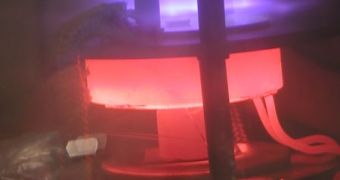Scientists from the University of Texas in Dallas (UT), working together with colleagues around the world, have manged to finally create one of the most interesting and applicable materials to date. They have shaped one of the lightest compounds to have ever been generated, which is less dense than air, into an artificial muscle.
But the kicker is that it can also contract very strongly when an electrical current passes through it. In addition, the contractions are almost instantaneous, just as those of human muscles when impulses from the brain pass through them.
“These artificial muscles are very lightweight and can do wonderful things. (...) These sheets of carbon nanotubes (...) are of great practical interest for LEDs, solar cells, and other applications,” UT researcher Ray Baughman, the leader of the new study detailing the find, published in this week's issue of the scientific journal Science, explains.
Aerogels are some of the most innovative materials in the world, as 99.8 percent of their internal structure is made from air. They have been extensively used in space exploration, for gently trapping particles of space dust and other ones to be brought back to Earth for study. Artificial muscles have also been around for a while, but the two technologies have thus far kept relatively to themselves, and have not been combined in any manner.
These engineered muscles work on the same basic principles as their human counterparts, in that they are elastic materials that contract as soon as an electrical charge passes through them. The main issue with these materials is that they can only operate within limited temperature ranges, on account of the fact that they most often contain liquids, which solidify or evaporate when subjected to low or high temperatures, respectively.
Baughman says that the new aerogel material, made from carbon nanotubes, is so light that it beats the current Guinness Book record-holder, a compound made of silicon dioxide, ten times over. He adds that a sheet of the new material spread over an acre of land would weigh less than an ounce. The thing about it is that it changes its mechanical response according to the angle of the force that is acting on it.
Pushed just right, it becomes stronger than steel. A slight variation in the angle of the applied pressure, and it becomes more elastic than the finest rubber sample. In addition, the previous limitations have been completely overcome, as the nanotubes are able to function at temperatures between -196 degrees Celsius to 1600 degrees Celsius (-321 degrees Fahrenheit to 2912 degrees Fahrenheit).
The new material easily allows electrical current to pass through it, and is also completely transparent. But, because it requires large voltages traveling through it in order to contract, it's very unlikely that it will be used with humans, as prosthetics. Rather, it will undoubtedly find applications in boosting OLED technologies, as well as in advanced solar panels and incandescent light bulbs.

 14 DAY TRIAL //
14 DAY TRIAL //